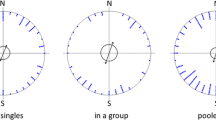Summary
Young pigeons were kept in an aviary from the time of weaning until the time of displacement 3–5 months later. The two compartments of the aviary were differentially shielded by surrounding walls, and birds of both compartments were released simultaneously. During six years, seven types of shieldings were used (Fig. 1). Releases were conducted at four sites in the cardinal directions (distances about 100 and 30 km, respectively). Initial bearings and distributions of recoveries led to the following conclusions (Figs. 3 and 4):
-
1.
Visual shielding of the environment up to about 10° above the horizontal plane does not influence long-distance orientation, provided that the shielding does not also impair the airflow through the aviary.
-
2.
Homeward orientation is drastically reduced if the aviary is surrounded by walls made of glass.
-
3.
Homeward orientation from all four directions persists if the pigeons lived in corridors between two solid walls permitting airflow either along the N-S axis or along the E-W axis.
-
4.
The preferred compass direction (PCD) of pigeons which lived in this aviary in unscreened conditions is SSW. In the initial bearings, this PCD is more pronounced than the tendency toward home.
-
5.
The PCD is reversed to NNE in pigeons which lived in a corridor open at east and west (but is unaffected by a N-S corridor).
-
6.
The results obtained with the corridor aviaries do not support the olfactory navigation hypothesis as it stands so far (cf. Papi, 1976).
Some aspects of circular statistics are discussed in the Appendix.
Similar content being viewed by others
References
Baldaccini, N.E., Benvenuti, S., Fiaschi, V., Papi, F.: Pigeon navigation: Effects of wind deflection at home cage on homing behaviour. J. Comp. Physiol. 99, 177–186 (1975)
Baldaccini, N.E., Benvenuti, S., Fiaschi, V., Ioalé, P., Papi, F.: Investigation of pigeon homing by means of ‘deflector cages’. In: Animal migration, navigation, and homing. Schmidt-Koenig, K., Keeton, W.T. (eds.), pp. 78–91. Berlin, Heidelberg, New York. Springer 1978
Batschelet, E.: Statistical methods for the analysis of problems in animal orientation and certain biological rhythms. Washington, D.C.: Am. Inst. Biol. Sci. 1965
Batschelet, E.: Recent statistical methods for orientation data. In: Animal orientation and navigation. Galler, S.R., et al. (eds.), pp. 61–91. Washington, D.C.: NASA (SP-262) 1972
Batschelet, E.: Second-order statistical analysis of directions. In: Animal migration, navigation, and homing. Schmidt-Koenig, K., Keeton, W.T. (eds.), pp. 3–24. Berlin, Heidelberg, New York: Springer 1978
Hartwick, R., Kiepenheuer, J., Schmidt-Koenig, K.: Further experiments on the olfactory hypothesis of pigeon navigation. In: Animal migration, navigation, and homing. Schmidt-Koenig, K., Keeton, W.T. (eds.), pp. 107–118. Berlin, Heidelberg, New York: Springer 1978
Keeton, W.T.: The orientational and navigational basis of homing in birds. Adv. Study Behav 5, 47–132 (1974)
Keeton, W.T., Kreithen, M.L., Hermayer, K.L.: Orientation by pigeons deprived of olfaction by nasal tubes. J. Comp. Physiol. 114, 289–299 (1977)
Kramer, G.: Über die Heimfindeleistung unter Sichtbegrenzung aufgewachsener Brieftauben. Verh. Dtsch. Zool. Ges. 1958, 168–176 (1959a)
Kramer, G.: Recent experiments on bird orientation. Ibis 101, 399–416 (1959b)
Kramer, G., St. Paul, U.v.: Das Heimkehrvermögen gekäfigter Brieftauben. Ornithol. Beob 51, 4–12 (1954)
Mardia, K.V.: Statistics of directional data. London-New York: Academic Press 1972
Papi, F.: The olfactory navigation of the homing pigeson. Verh. Dtsch. Zool. Ges. 69, 184–205 (1976)
Papi, F., Fiore, L., Fiaschi, V., Benvenuti, S.: Olfaction and homing in pigeons. Monit. Zool. Ital. (N.S.) 6, 85–95 (1972)
Papi, F., Keeton, W.T., Brown, A.I., Benvenuti, S.: Do American and Italian pigeons rely on different homing mechanisms? J. Comp. Physiol. 128, 303–317 (1978)
Schmidt-Koening, K.: Experimentelle Einflußnahme auf die 24-Stunden-periodik bei Brieftauben und deren Auswirkungen unter besonderer Berücksichtigung des Heimfindevermögens. Z. Tierpsychol. 15, 301–331 (1958)
Wallraff, H.G.: Über die Heimfindeleistungen von Brieftauben nach Haltung in verschiedenartig abgeschirmten Volieren. Z. vergl. Physiol. 52, 215–259 (1966)
Wallraff, H.G.: The present status of our knowledge about pigeon homing. In: Proc. XIV Int. Ornithol. Congr. Snow, D.W. (ed.), pp. 331–358. Oxford-Edinburgh: Blackwell 1967
Wallraff, H.G.: Über die Flugrichtungen verfrachteter Brieftauben in Abhängigkeit vom Heimatort und vom Ort der Freilassung. Z. Tierpsychol. 27, 303–351 (1970a)
Wallraff, H.G.: Weitere Volierenversuche mit Brieftauben: Wahrscheinlicher Einfluß dynamischer Faktoren der Atmosphäre auf die Orientierung. Z. vergl. Physiol. 68, 182–201 (1970b)
Wallraff, H.G.: Homing of pigeons after extirpation of their cochleae and lagenae. Nature [New Biol.] 236, 223–224 (1972)
Wallraff, H.G.: Das Navigationssystem der Vögel. München-Wien: Oldenbourg 1974
Wallraff, H.G.: Preferred compass directions in initial orientation of homing pigeons. In: Animal migration, navigation, and homing. Schmidt-Koenig, K., Keeton, W.T. (eds.), pp. 171–183. Berlin-Heidelberg-New York: Springer 1978a
Wallraff, H.G.: Social interrelations involved in migratory orientation of birds: Possible contribution of field studies. Oikos 30, 401–404 (1978b)
Wallraff, H.G.: Homing strategy of pigeons and implications for the analysis of their initial orientation. Proc. XVII Int. Ornithol. Congr. (in press) (1979)
Wallraff, H.G., Graue, L.C.: Orientation of pigeons after transatlantic displacement. Behaviour 44, 1–35 (1973)
Windsor, D.M.: Regional expression of directional preferences by experienced homing pigeons. Anim. Behav. 23, 335–343 (1975)
Yodlowski, M.L., Kreithen, M.L., Keeton, W.T.: Detection of atmospheric infrasound by homing pigeons. Nature 265, 725–726 (1977)
Author information
Authors and Affiliations
Rights and permissions
About this article
Cite this article
Wallraff, H.G. Goal-oriented and compass-oriented movements of displaced homing pigeons after confinement in differentially shielded aviaries. Behav Ecol Sociobiol 5, 201–225 (1979). https://doi.org/10.1007/BF00293306
Received:
Issue Date:
DOI: https://doi.org/10.1007/BF00293306




